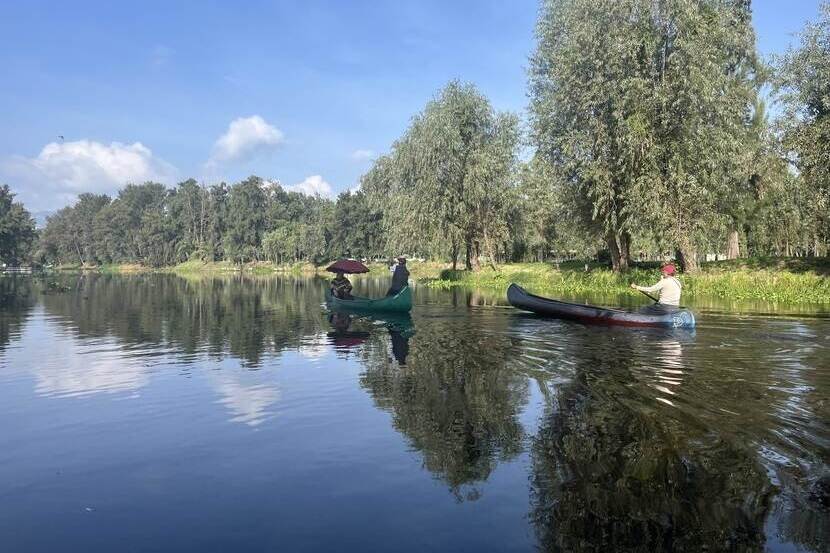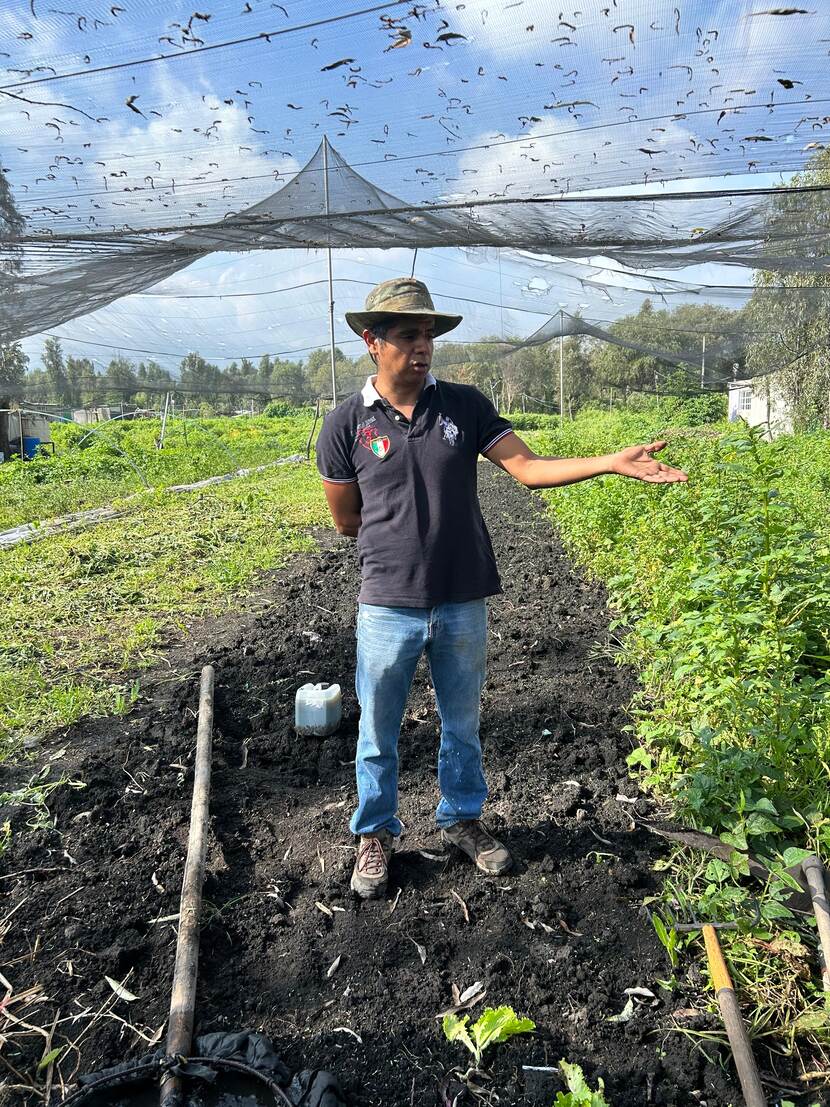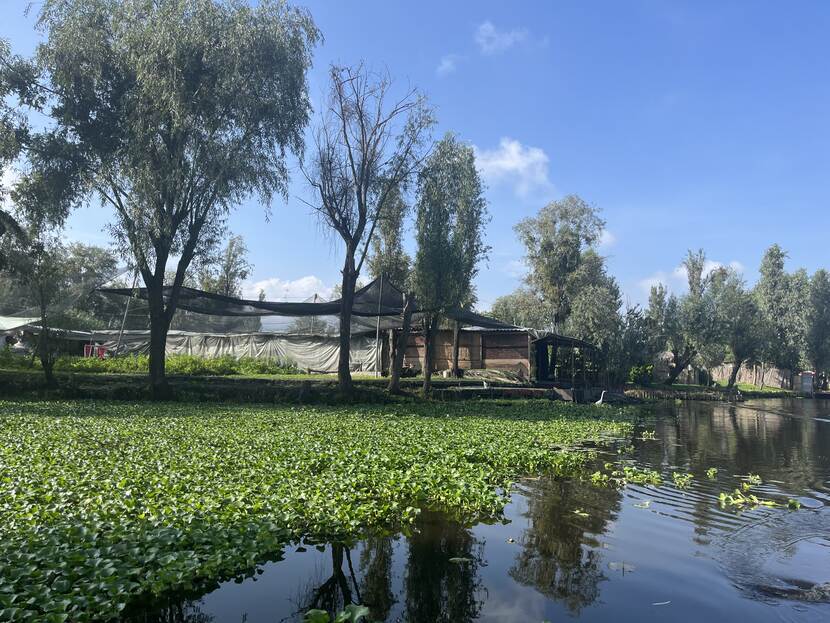Working on biodiversity in Mexico: using pre-Hispanic knowledge in Xochimilco
Mexico’s diverse ecosystems are under growing pressure from deforestation, unsustainable agricultural practices, climate change, and a rapidly expanding population. The Netherlands Agricultural Network (LAN) team at the Dutch Embassy in Mexico City has taken this challenge head-on by developing a comprehensive biodiversity strategy with the support of the Global Youth Biodiversity Network (GYBN). This article explores the team’s key priorities for safeguarding Mexico’s biodiversity and highlights a significant project focused on reviving sustainable, pre-Hispanic farming methods in the chinampas of Xochimilco—a practice dating back to the Aztec civilization.

On 1 October 2024, the new Mexican Government took position. With Claudia Sheinbaum, the country has a climate scientist as president. It is clear that biodiversity will be an important topic in the government program. Alicia Bárcena, the Minister of Environment, has just announced a national restauration strategy, meant to restore vulnerable ecosystems.
Furthermore, Mexico is determined to restore 30% of its mangroves in 2030. Nature and biodiversity are also an important part of the work of the Netherlands Agricultural Network (LAN) team in Mexico. To have a clear strategy, the team questioned itself: how can we support a big country like Mexico in protecting its biodiversity and what should be our focus? To answer this question, the LAN team developed a biodiversity road map with support of the Global Youth Biodiversity Network chapter Mexico.
This article explores the priority topics of the LAN team in Mexico in the field of biodiversity. In addition, it dives into one of their projects in Mexico - improving biodiversity through promoting sustainable, pre-Hispanic agricultural practices in the chinampas of Xochimilco.

Biodiversity road map
By contracting the Mexican youth from the Global Youth Biodiversity Network (GYBN), the LAN team tapped into their knowledge on biodiversity and gave them a role in policy making. The youth consultants shared in depth their insights about state priorities and highlighted the importance of indigenous communities in the protection of ecosystems. Based on the main challenges for biodiversity in Mexico and the expertise that the Netherlands has to offer (for example knowledge on mangrove restauration, Nature-based Solutions, integrated water management, satellite data for monitoring of deforestation and the collection of sargassum), the LAN team has defined the following priorities for their 2024 – 2028 biodiversity road map:
-
Making food systems nature-inclusive
-
Protecting coastal and wetland ecosystems
-
Halting deforestation
Promoting social inclusivity, mobilizing finance and partnerships as well as having an ecosystem approach are reflected in all the activities of the team. A project that implements the first two priorities is the project on agricultural practices in the chinampas of Xochimilco.
‘To have a clear strategy, the LAN team in Mexico questioned itself: how can we support a big country like Mexico in protecting its biodiversity and what should be our focus?’
Xochimilco: where history meets ecosystem services
The area of Xochimilco is part of the ancient lake system in which Mexico City is built. It’s renowned for its chinampas, agricultural plots that have existed since Aztec times. In the Mesoamerican way of farming, farmers constructed rectangular and floating pieces of land, by layering soil, mud and organic matter on top of wooden frames. Those frames were anchored by trees like willows.
Surrounded by canals, the chinampas created highly effective systems for irrigation and crop growth. Due to moderate weather conditions, fertile soil and water availability, the chinampas provide 5 to 7 harvests per year. It’s estimated that with this efficiency, the system fed 200.000 persons during the Aztec Empire.
Although man-made, the chinampas provide a lot of what we would nowadays call ‘ecosystem services’. It cools Mexico City by recharging groundwater reserves and sequestering large amounts of carbon. Furthermore, it is a sanctuary for animal species, such as the axolotl, a rare and endangered kind of salamander that can be found in Mexico only.
For these unique characteristics, UNESCO recognizes Xochimilco as a World Heritage Site, and the Food and Agriculture Organization of the United Nations gave it the status of a Globally Important Agricultural Heritage System. Since 2004, it has also been an official RAMSAR-site, as many migratory birds arrive here.

Climate change and encroachment
The area of Xochimilco faces several challenges, namely:
1. Climate change and the expansion of Mexico City
Although the greater area of Mexico City already has 22.5 million inhabitants, the capital is still expanding. This puts a lot of pressure on land use and the city is encroaching on the area of Xochimilco. Its surface has shrunk enormously and about 80% of the agricultural chinampas are abandoned. In addition, climate change has increased the temperature in Xochimilco and causes longer droughts. The water levels are declining, and hail is damaging the crops.
2. Unsustainable irrigation methods and agricultural practices
Traditional practices like intercropping have been replaced by intensive use of agrochemicals, fertilizers and monoculture (commercial, non-native seeds). Furthermore, many farmers irrigate their farmlands with too much pumped water. This results in crop fungal and bacterial infections, damaging the soil and plants in early stages of growth.
3. Water quality and water availability
Due to discharge of urban wastewater and the use of fertilizers, the water quality has declined and aquatic plants like invasive water lilies cause damage to the biodiversity. Today, the area retains only 2% of the fresh water that was originally in the basin.
Improving agricultural practices and water quality in Xochimilco
To face these challenges, the LAN team in Mexico has financed a project in cooperation with the Mexican NGO Pronatura and three local farmer cooperatives. The project aims to improve water quality and agricultural practices. In the project, biofilters are installed in the canals to improve water quality and to provide a refuge for the axolotl.
Another added value of the biofilters is that due to the better water quality, the crops can now be certified as organically produced. The certification of agricultural products in the chinampas of Xochimilco guarantees the quality, origin, and sustainable practices of these foods, strengthening their market value and promoting local consumption. By obtaining certification, chinampa producers receive recognition that allows them to access new markets and consumers willing to pay a fair price for high-quality products.
Field schools, which are extended and continued through the project, provide farmers with the techniques and knowledge to improve their agricultural practices by adopting an agroecological, pre-Hispanic approach. With this approach, farmers can again produce without agrochemicals and restore and preserve biodiversity on their lands.
During a field visit to Xochimilco, Meike van Ginneken, Water Envoy for the Kingdom of the Netherlands, gives her impressions of the visit and the importance of sustainable water solutions in agriculture.
Talking to farmers
During a visit to Xochimilco, the LAN team talked to Don Lucio, one of the farmers participating in the project. Don Lucio is working on the chinampa that used to be his father’s. He used agrochemicals for many years, but changed to growing his crops with only biofertilizers, such as worm compost. He felt he needed to adjust his previous practices, as he noticed a decline in biodiversity and the effects of climate change. With the new practices, his crops take more time to grow, yet they are more resilient, and the production is bigger. He can harvest six to seven times a year.
In the video below, Agricultural Counselor Wendele van der Wiele asks Don Lucio about his practices.
Other LAN activities for biodiversity in Mexico
The project in Xochimilco is not the only biodiversity project that the LAN team in Mexico supports. The team keeps developing concrete interventions on the three priority topics. Recently, it has supported the preparation of a Mexican youth delegation for the COP in Cali. Furthermore, it works on integrated water management and agriculture in the watershed of La Laguna de Zapotlán. In the watershed, it supports collective action of NGO's, producers, the government and academia in the watershed by organizing workshops, facilitating the dialogue, and mobilizing technical expertise to support project development. Also, the team supports the development of a mangrove restauration project in Mexico, an initiative from the Mangrove Breakthrough Alliance.
More information
Would you like to know more about biodiversity conservation efforts is Mexico? Please go to the country page of Mexico at the website Agroberichtenbuitenland.nl of the Dutch Ministry of Agriculture, Fisheries, Food Security and Nature. You can also send an email to the LAN team in Mexico City: MEX-LVVN@minbuza.nl.
This article is part of the 13th edition of the e-magazine Agrospecial, titled "Peace with Nature: Global Biodiversity Commitment" (originally published on October 9, 2024).
In this edition, the Netherlands Agricultural Network (LAN) explores the crucial role of biodiversity in agriculture and nature in the context of the COP16 of the Convention on Biological Diversity (CBD) in Colombia. Agricultural Counselors from over 18 countries share their involvement in initiatives that foster the protection and sustainable use of biodiversity, highlighting the complex interdependence between biodiversity, water and soil management. In these efforts, cooperation, innovation and knowledge exchange are key, and LAN plays a crucial role in mainstreaming this global commitment.